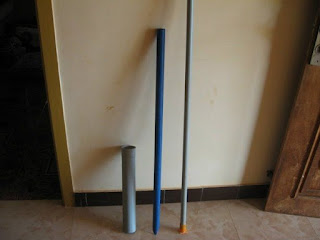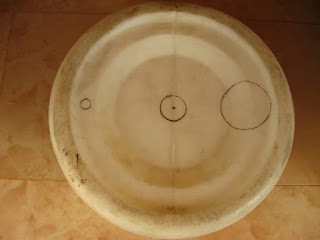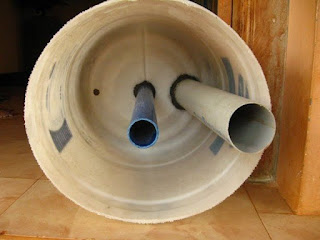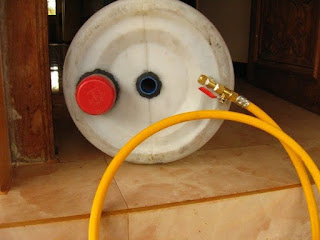How to make your own HOME COMPOSTER FOR FOOD WASTE FROM KITCHEN
Inputs:
Do
Compost: ∙ Vegetable Scraps ∙ Fruit rinds, cores, pits and peels ∙ Coffee
grounds and filters ∙ Tea bags and loose leaf tea ∙ Pasta, breads, cereals,
grains ∙ Paper napkins, towels ∙ Egg shells
Do Not Compost: ∙ Meat ∙ Fish and poultry ∙
Bones ∙ Oily foods ∙ Cheese ∙ Butter and dairy products ∙ Other animal products
Process:
Waste is collected and brought to the site where it is first
sorted out and shredded to a consistent size. cut everything down to 1.5"
size It is than put inside the composter.
One
of the easiest ways to compost non-meat food waste is using a garbage can sunk
in the ground. You can use an old or new can, but it should have a
tight-fitting lid. Galvanized metal cans work well and do not rust. Volume as per capacity. Drill or punch about 30 drain holes, 1/4 to 3/8
inches in diameter, in the can bottom and around the lower sides. If the lid is
not tight-fitting or if you do not have a lid, you can make a lid from a piece
of plywood and strap it on with bungee cords. Dig a hole in a well-drained corner of your yard and set the can into the hole, pushing
soil around the sides to firmly plant the can (see our drawing). You’re ready to
compost!
Composting
To compost, put vegetable-based food scraps in your can, alternately layering
with some dry leaves, sawdust, or shredded newspaper. The texture of the
finished compost will depend on the materials composted and how long they spend
in the can, and may range from a wet slurry to a dark, crumbly substance
similar to soil. Depending on your food habits, your composter will likely fill
in four to eight months
Harvesting
the Compost To harvest, shovel the top layer of un-composted food to one side
and shovel the dark, soil-like compost from the bottom. Finished compost should
be dry and sweet smelling; if it is wet and smelly, mix it with some soil
before using. In the meantime, make room for more food scraps in the can by
replacing the layer of un-composted food in the can or burying it in a trench
in the garden. Or, set up a second can. Use one until full and then switch to
the second, switching any un-composted food scraps between the two. Using
Finished Compost The most common uses of compost are as a soil enhancer for
planting.
How
to make or get accelerators or Bio cultures?
Bio cultures
are required with cooked foods it is necessary to accelerate the decomposition.
WE SUPPLY THIS BIO CULTURE
HOW IT WORKS:
Carbon/Nitrogen Ratio: = 30:1
This is the first law one has to adhere to in order to ensure
rapid composting. Every ingredient you add into your
composter has it's own inherent C/N ratio, like
This is the first law one has to adhere to in order to ensure
rapid composting. Every ingredient you add into your
composter has it's own inherent C/N ratio, like
·
Grass clipping
= 15:1
·
Soft wood chips
= 226:1
·
Vegetable Waste
= 11:1
·
Poultry Manure
= 10:1
What you decide put into your composter the first day is the
weighted average of each of the individual items' C/N Ratio.
My ingredients, for example, are predominantly Grass Clippings
and Soft wood chips and I have computed my ratio to be 3 parts
grass clippings and 2 parts soft wood chips. You have to
perform the same calculation as I have, in order to arrive at
your final predominant ingredient ratio
.
Note: Remember to cut everything down to 1.5" size.
Water
A 50% water content is necessary. This means the composter
may have to be watered from time to time if it appears dry and
the side vents will have to be left open if it appears wet. 50%
water content is as wet as a wrung out sponge. If you see
water settling on the bottom, it is too wet.
After the 3rd day of composting, when the waste (future
compost) has gone down to half it's original volume, the 55
Gallon drum is now only 1/2 full. This amount is below it's
critical mass and will loose heat at night when it the ambient is
cooler. This way you will loose 8 hours of valuable composting
time cutting into your 17 day harvest cycle. What I do is place a
20mil plastic sheet over the waste in order to insulate the
material and speed up the process.
Aeration
Turn the barrel at least once every day. If you do that, the
entire process will take 2.5 weeks, or 17 days. If you turn every
other day and all other conditions are correct, the process will
take 25 days. Quite an amazing feat, considering a left alone
compost pile will take a whole year to mature.
Fine Tuning
If you keep to the turning/tumbling schedule, one of 3 things
can go wrong and needs to be rectified mid-course.
Note: Remember to cut everything down to 1.5" size.
Water
A 50% water content is necessary. This means the composter
may have to be watered from time to time if it appears dry and
the side vents will have to be left open if it appears wet. 50%
water content is as wet as a wrung out sponge. If you see
water settling on the bottom, it is too wet.
After the 3rd day of composting, when the waste (future
compost) has gone down to half it's original volume, the 55
Gallon drum is now only 1/2 full. This amount is below it's
critical mass and will loose heat at night when it the ambient is
cooler. This way you will loose 8 hours of valuable composting
time cutting into your 17 day harvest cycle. What I do is place a
20mil plastic sheet over the waste in order to insulate the
material and speed up the process.
Aeration
Turn the barrel at least once every day. If you do that, the
entire process will take 2.5 weeks, or 17 days. If you turn every
other day and all other conditions are correct, the process will
take 25 days. Quite an amazing feat, considering a left alone
compost pile will take a whole year to mature.
Fine Tuning
If you keep to the turning/tumbling schedule, one of 3 things
can go wrong and needs to be rectified mid-course.
·
Add/subtract Water.
·
Add Carbon rich
ingredient (High C/N Ratio).
·
Add Nitrogen Rich
ingredient (Low C/N Ratio).
As long as the ingredients are moist, a pile not heating up over
120˚F indicates not enough nitrogen, while one that smells bad
indicates not enough carbon. Either condition can be
corrected by adding the required ingredient.
Note: Never add anything else, mid course, or your 17 day
timetable will be altered.
COMPOST
The end product is
this sweet smelling black gold that has to be sun
dried for a day or two (10% moisture content) and stored or
used immediately in your garden. One Ton of BMW will produce approx. 500 KG of compost
dried for a day or two (10% moisture content) and stored or
used immediately in your garden. One Ton of BMW will produce approx. 500 KG of compost
|














